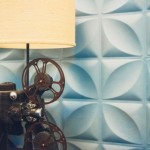Online Film School Free » Film Directing Course » Film Cinematography for Directors » The Three Point Lighting Technique
Film Light With The 3 Point Lighting Technique
Table of Contents
Toggle
When you light a scene it is not enough to just bring enough light so the character will be seen. You also need to give the photographed object a three-dimensional look. This illusion will be created with the shadows and highlights in the shot. The great advantage of this technique is that you can do it even without any expensive lighting equipment.
The three point lighting technique is a classic Hollywood lighting technique. There are many more lighting techniques out there, but this is the most basic one and it can be developed into many other variations.If you want to learn how to set up light in a scene, you have to start from this scheme. It is built from key light, fill light and backlight.
Before you start working on the Three points light scheme
If you read the 5th lesson about Tips for lighting a scene, then you already know this. I’m going to repeat it here because it is very important to remember.
You can start working on lighting only after the shot has been set and the camera angle has been chosen. You have to make sure you know, where the actors will stand, move and wich way they will face. You should also think what is allegedly the main source of light in the scene (is it the window in the room, the lamp etc).
Key light
- The key light is the main light in the scene. (It doesn’t have to be the brightest, though) and It is the first light we establish. The key light is aimed directly at the object and it will determine the shape and form of the photographed object.
- When planning the key light think about what is the main source of light in the scene. If the main light needs to come from a window, make sure your key light looks like it’s coming from a window.
There are several types of key light. There is the point source key light,
a spotlight or an area light, so the first thing you need to decide
is which type of key light you want to use.
The second thing you need to decide is the position of the key light. The angle that you’ll choose to put your key light will create shadows that will tell us what kind of location it is and even what time of day it is. - The conventional key position is about 45 degree to the side of the object, eye level and in front of it, but I really recommend playing with it. Put the key light in different positions (even behind the subject) and see what kind of shot you are getting.
Look at the person’s nose and at the shadow it casts. Does it look natural to you? Are the eyes too dark (happens when the key light is too high)?
If your source light in the scene suppose to be a lamp from the ceiling, and the shadow your object’s nose make is in the mouth, then it makes sense.
Take the time you need to set the right key light. All the other lights will be set by the strength, angle, and color of the key light. - When shooting outside the sun is usually the key light and the photographer need to decide if he wants to arrange the whole scene by the sun or to wait until the sun is in the right position for him.
Fill light
- After we set the key light, we have a big contrast between the lit area and the dark area, so now we need to balance the key light. The fill light’s purpose is to soften the key light’s edges so the shadows will be softer and also cover a side of the photographed object that the key light can’t reach.
- usually, it’s the second light you set and usually, the light is positioned in the opposite to the key light and in the same height as the key light.
- Before you set the fill light you need to think what is allegedly the second source of light in the scene (is it a candle in the room, a small lamp, etc).
- It can also help if the key light and the fill light overlap each other.
- Many times the key light can be produced by a reflector like a white wall or a card box. That will create a softer light that sometimes look better
The problem with fill light is that it might cast a shadow of the subject in the background. When that happen you need to find a way to diffuse the light further so the shadow won’t be so bad. You can move the light close to the photographed subject. Another solution might be to move the subject and the fill light as much as possible from the background.
Backlight
- By highlighting the subject’s edges, the backlight will separate the subject from its background. The backlight is usually positioned behind the subject and above it.
- The backlight should be used also to lit the other elements in the scene. Only after seeing the light that the key and fill created, you can tell how much light you’ll need for the background. Sometimes You may not need it at all.
- The trick with backlight is not to lit the background more than the subject.
The three point set up is a great technique, that once you will control it, you will be qualified to work in the industry, but I suggest to always try and develop it into something more creative. The three point lighting doesn’t have to be as strict as it sounds. It can be used for many lighting styles. For example, you can decide to have a few key lights on each object in the shot. Play around and work by the logic of the scene.
If you have any suggestions for developing the Three point lighting technique, please comment and let us all know.



